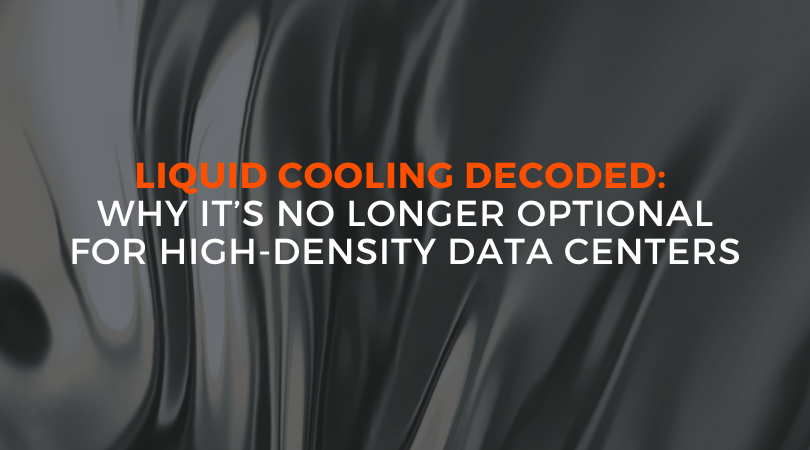Suggested URL:
/liquid-cooling-myths-reality-high-density-data-centers
Short Excerpt: For years, liquid cooling has been treated like a novelty. Reserved for hyperscale giants or cutting-edge enterprises. But that mindset is obsolete. If your facility is serious about high-density compute, especially AI, machine learning, or GPU-intensive workloads, air cooling alone is no longer enough.
The myths are loud. The reality is louder.
For years, liquid cooling has been treated like a novelty. Reserved for hyperscale giants or cutting-edge enterprises. But that mindset is obsolete. If your facility is serious about high-density compute, especially AI, machine learning, or GPU-intensive workloads, air cooling alone is no longer enough.
At Donwil, we’ve seen what happens when data centers try to scale with outdated thermal strategies. Heat wins. Performance drops. Expansion stalls. So let’s cut through the noise and get clear on the facts. It’s time to separate myth from mission-critical reality.
Myth #1: “Water and Electronics Don’t Mix – Too Risky”
The logic is familiar and outdated. Mixing liquid and servers triggers every instinct to pull back. You’ve spent years designing systems to keep moisture out of the rack. But what most people picture (dripping pipes over live equipment) doesn’t reflect how modern liquid cooling actually works.
Today’s systems are engineered for precision and safety. Closed-loop, dielectric-based cooling eliminates electrical risk at the hardware level. These fluids don’t conduct electricity. In fact, you could submerge active electronics in them without damage.
More importantly, these are not experimental setups. They’re tightly controlled thermal systems, often more predictable and arguably safer than traditional chilled water loops that circulate across entire floors.
The real risk is sticking with legacy air systems that can’t keep up with modern heat loads.
Myth #2: “It’s Too Complicated to Deploy and Maintain”
If liquid cooling sounds like overkill, it’s because the industry hasn’t updated its narrative. The reality is very different from what it was five years ago.
Modern liquid cooling is modular, clean, and scalable. You’re not rebuilding your facility. You’re upgrading it. Direct-to-chip systems integrate into existing racks. Rear-door heat exchangers drop into standard form factors. Immersion tanks arrive preconfigured. And the supporting infrastructure? Prefab skids, smart piping, and sensor-driven automation.
Complexity didn’t disappear. It just got smarter. The mess and micro-management of balancing hot and cold aisles? Gone. Liquid removes heat directly at the source, streamlining operations and giving you surgical control over thermal conditions.
Myth #3: “It’s Just for Large Enterprise Data Center Centers”
If you’re deploying AI models, training large language models, handling real-time data analytics, or just stacking dense racks of GPUs, you’re already operating in high-performance territory. And that territory has new thermal demands.
Rack densities over 15–20 kW used to be exceptional. Now, they’re routine. And air cooling struggles to maintain uptime and efficiency at that level. Liquid cooling lets you push hardware harder, for longer, without throttling or escalating risk.
What Liquid Cooling Actually Delivers
Let’s put the myths aside and focus on what really matters: the tangible business value liquid cooling brings to your data center. This isn’t about theory. It’s about performance, efficiency, and building smarter infrastructure that is equipped for today and engineered for tomorrow.
Peak Performance, Always
This is where liquid cooling proves its worth instantly. Traditional air-cooled environments often force your hardware to compromise by dialing down speeds to prevent overheating. That’s thermal throttling, and it quietly drains performance and ROI every hour of the day.
Liquid cooling changes that equation. By removing heat directly at the source—right off the CPU or GPU—it allows your systems to operate at full power without interruption. No slowdowns. No compromises. Just pure, reliable compute. If you’re investing in high-performance hardware, you deserve 100 percent of the capability. Liquid cooling ensures you unlock the full value of your infrastructure.
Serious Energy Savings
Cooling has always been one of the biggest operational expenses in any data center. But what if your thermal strategy worked with physics instead of against it?
Liquid has vastly better heat transfer properties than air. That means you can move heat more efficiently using less energy. The result is a noticeable drop in your Power Usage Effectiveness (PUE). Your chillers work less. Your fans spin slower. Your overall power draw declines in a measurable way.
Beyond the financial gains, this approach helps you hit critical sustainability targets. With ESG pressures increasing and utility costs rising, switching to liquid cooling does more than improve operations. It positions your business as a responsible, future-forward leader.
Smaller Footprint, Greater Density
Real estate is expensive. Expansion is disruptive. And floor space is finite. Liquid cooling gives you a smarter way to scale without breaking the layout or the budget.
By enabling much higher rack densities, you can pack more compute power into every square foot. That means fewer racks, less cabling, and more room to grow within your current footprint. Whether you’re optimizing an existing facility or designing a new one, liquid cooling supports a vertical growth strategy that saves time, money, and space.
Future-Ready Infrastructure
Here’s the reality. The next generation of processors and accelerators are pushing beyond the thermal limits of air-cooled systems. AI workloads, multi-GPU configurations, and data-intensive operations are already testing the boundaries of traditional cooling methods.
Planning a data center without liquid cooling in mind is planning to fall behind. Or worse, planning to retrofit in a moment of crisis.
Liquid cooling is not just a short-term fix. It is a long-term strategic move that ensures your infrastructure is ready for what comes next. It lets you adopt new technologies faster, scale with confidence, and stay competitive in a space where every second of uptime and every watt of power matters.
The Donwil Difference: Strategy First, Tech Second
At Donwil, we don’t chase trends. We build infrastructure that lasts.
Every facility is different, and every workload has nuance. We help you evaluate where liquid fits, what approach makes sense (direct-to-chip, immersion, hybrid), and how to scale it without disruption.
If you’re ready to stop reacting to rising rack temps and start proactively future-proofing your environment, let’s talk.

